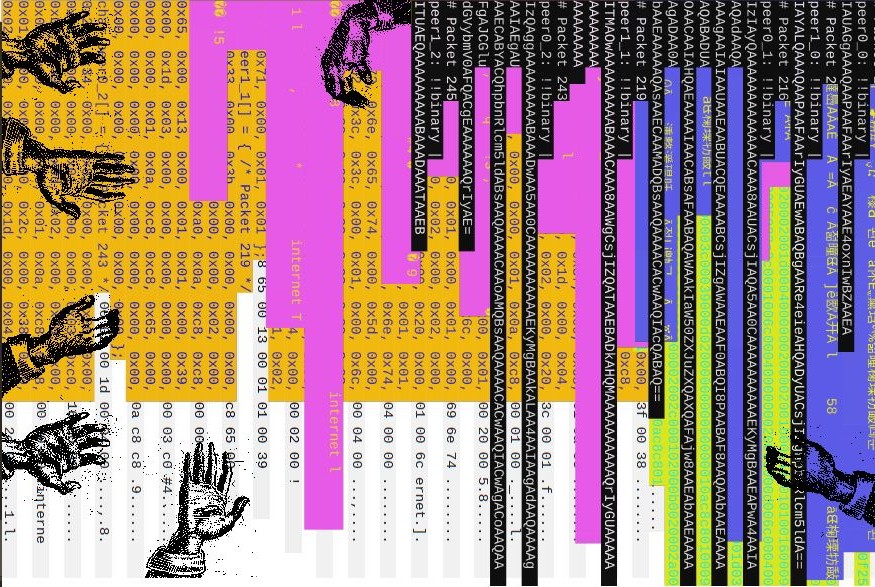
Authors: Larisa Blazic, Niels ten Oever
Information networks and technologies are proxies for power. The British colonial empire was held together by the electrical telegraph network called the ‚All Red Line‘ [0]. The development of the Arpanet, one of the precursors of the Internet, was spurred by the launch of the Sputnik satellite by the Soviet Union [1]. Some researchers claim that the nuclear threat by the Soviet Union inspired the distributed design of the Arpanet, to ensure that it would be fault-tolerant in case of a nuclear attack. This together with the frustration about the monopoly and restrictive management by telecommunication providers of communication networks, led the Internet to be developed as an end-to-end network. In such a network, innovation happens at the edges and the network itself is ‚only‘ responsible for the transportation of packets. The time of that design, however, has passed.
We want to interrogate existing and upcoming information infrastructures because according to Keller Easterling ‚infrastructure sets the invisible rules that govern the spaces of our everyday lives’ [2]. She adds that ‚changes to the globalising world are being written, not in the language of law and diplomacy, but rather in the language of infrastructure’. To understand our own lives, we need to understand the infrastructure because both have become closely intertwined to an extent that they are almost indistinguishable. Or in the words of John Culkin: ‚We shape our tools and then our tools shape us‘.
The reason that the Internet could handle the increase in traffic during the start of the Covid-19 pandemic, when suddenly even more societal processes became digitally mediated, can be attributed to the role of Content Distribution Networks. These networks function as caching servers to store popular content closer to the user. This decreases stress on the network because large content, such as video files, don’t need to be streamed from another continent, but from a data center close to you. You, however, do not know this. You asked for a video directly from a website, instead, you are getting it from a local server. This might be great for load balancing, it also introduces local differences in content and less transparency in the network. If you don’t know which server you are talking to – how can accountability take shape? What rules of which jurisdiction are applied? And how do I know whether the content that I receive is the same as someone else receives, or is this an individually tailored information, or censorship, regime?
With the roll-out of 5G and networking paradigms such as ’software defined networking‘ and ’network function virtualization‘, increasingly networking is not dependent on the logic gates of dedicated hardware, but rather on the memory and processing power of new general-purpose devices. This shift is replacing protocols and rules with a governmentality that is characterized by software-based algorithmic optimization. Or in the words of Feamster and Rexford, it is ’networks running themselves‘ [3].
While more power is handed over to the network, the devices that are implanted in our daily lives become less and less visible – and thus making them harder to administer and control for end users. The edges of the network are smudged and users are being excommunicated from communication [4] and merged with the network to remove the final barrier of friction. This has to stop.
Users should not be created by the network. Especially not a network that is owned and run by transnational corporations. Users are citizens, not merely commodified consumers that can be managed by infrastructure-induced personalized advertisement, surveillance, and censorship regimes. We demand networks, not just services, that reflect social norms and public values. We demand a network we can negotiate with: a network that is a server, not a controller. We don’t want to be the individualized product of an advertising campaign that can purchase its own customization. We want collective bargaining power. We want to form associations and assemblies. We don’t want digital queens or kings, but we don’t want to become the chessboard either.
We want to control the dataplanes of possibility. We want to shape material society to our norms and beliefs. We want states and corporations to know and show how they impact our human rights, so we can jointly reconfigure the system. This cannot be done on algorithmically optimized black boxes. Information societies are incompatible with a patented infrastructure. A true information society can only be built on open hardware and open software. A patented software infrastructure from a European maker is not better than a Chinese or American one.
We do not want to import geopolitics into the tools of our daily lives. We cannot opt-out of infrastructure – therefore we demand that we can shape and play with it. One cannot outsource infrastructure in the same way one cannot outsource democracy. The infrastructures of our lives are not the property of corporations. In that sense, infrastructure cannot be owned by states or companies, but only by the people. Infrastructural property is the original sin. This is the new stacktivism [5] in which we shape social infrastructures after political goals.
[0] https://upload.wikimedia.org/wikipedia/commons/thumb/b/bd/All_Red_Line.jpg/920px-All_Red_Line.jpg
References
[1] Abbate, Janet. 1999. Inventing the Internet. Inside Technology. Cambridge, MA: The MIT Press.
[2] Easterling, Keller. 2014. Extrastatecraft: The Power of Infrastructure Space. Verso Books.
[3] Feamster, Nick, and Jennifer Rexford. 2017. “Why (and How) Networks Should Run Themselves.” ArXiv:1710.11583 [Cs], October. http://arxiv.org/abs/1710.11583.
[4] Galloway, Alexander R., Eugene Thacker, and McKenzie Wark. 2013. Excommunication: Three Inquiries in Media and Mediation. University of Chicago Press.
[5] Lovink, Geert. 2020. “Principles of Stacktivism.” TripleC: Communication, Capitalism & Critique. Open Access Journal for a Global Sustainable Information Society, 716–724.Malabou, Catherine. 2019. “Beyond the ‘Archic’ Principle.” Presented at the Spinoza Lecture, Amsterdam, February. https://www.uva.nl/shared-content/faculteiten/nl/faculteit-der-geesteswetenschappen/nieuws/2019/03/registraties-spinozalezingen-2019.html?origin=ItpKYHA1TqayysmgBfzvSw.